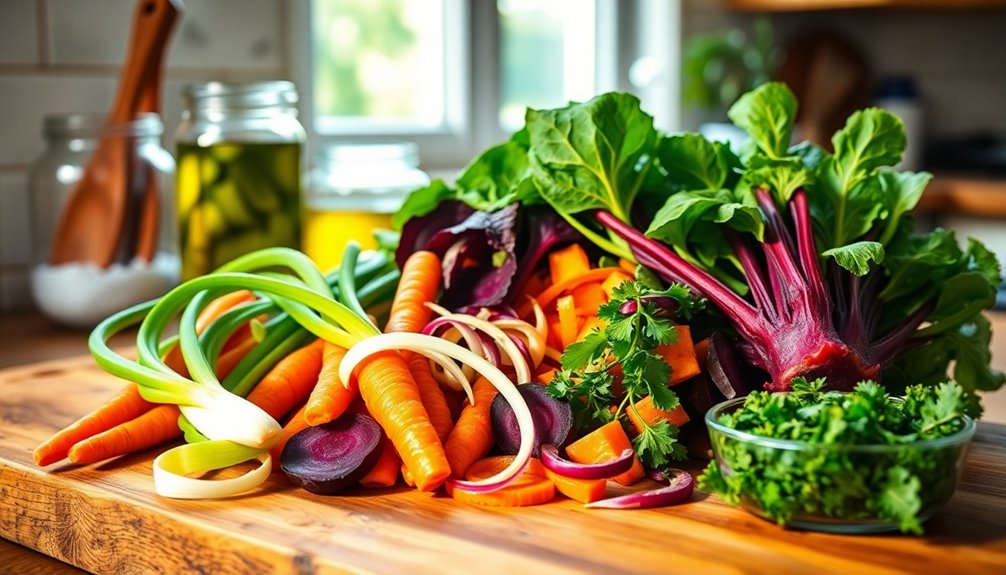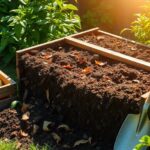You can easily repurpose food scraps into delightful dishes. Save those vegetable peels to create a flavorful homemade stock or turn stale bread into crunchy croutons. Overripe fruits make for delicious smoothies, while citrus peels add zesty flavor to your marinades. Don't forget to experiment with pickling your vegetable scraps for a tangy treat. If you have coffee grounds lying around, they can double as a natural exfoliant for your skin. Each scrap has potential, turning waste into culinary treasures. Keep exploring to discover even more creative ways to reduce waste and enhance your cooking experience.
Key Takeaways
- Create vegetable stock by saving and freezing vegetable scraps like onion peels, carrot tops, and celery ends for a flavorful broth.
- Make homemade croutons by tossing stale bread with olive oil, garlic, and herbs, then baking until crispy and golden.
- Use overripe fruits in smoothies by blending them with yogurt or nut butter for added creaminess and nutrition.
- Pickle vegetable scraps such as cucumber peels or radish tops in a vinegar brine with spices for a tangy, tasty treat.
- Repurpose coffee grounds by mixing them with coconut oil and sugar to create a natural exfoliating scrub for your skin.
Vegetable Stock From Scraps
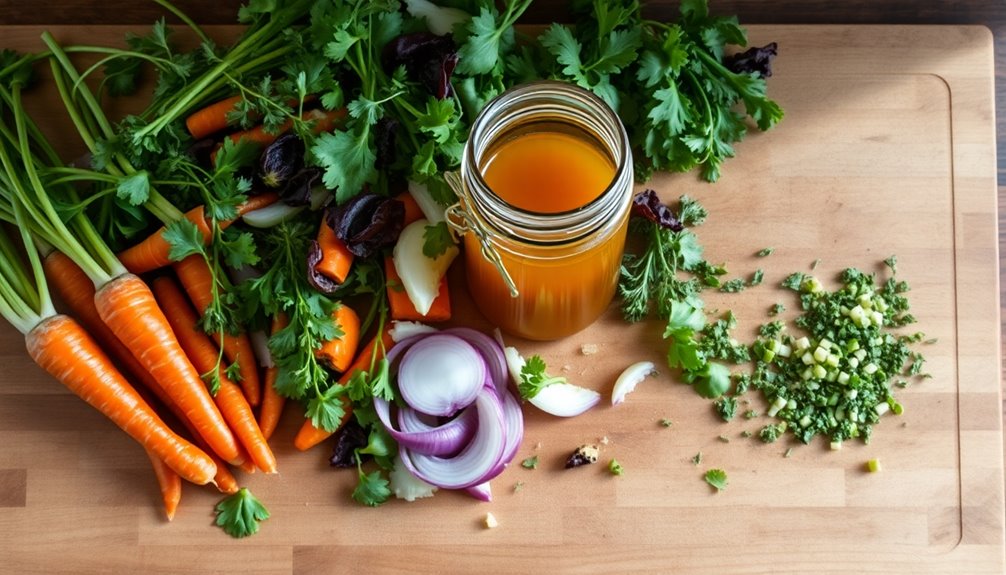
Creating a flavorful vegetable stock from scraps is a fantastic way to reduce waste and enhance your dishes. You might be surprised at how easy it's to turn leftover vegetable bits into rich, savory broths that elevate your cooking. Instead of tossing those carrot tops, onion skins, or celery leaves, save them in a bag in your freezer. When you're ready, just grab those scraps and let's get cooking!
Start by gathering your vegetable scraps and rinsing them to remove any dirt. In a large pot, combine your scraps with water, adding herbs like thyme or bay leaves for depth. Bring it to a boil and then let it simmer for an hour or so. The longer it simmers, the more robust your stock will be.
Strain out the solids, and voilà! You've got a flavorful broth that can be used in soups, risottos, or even as a base for sauces. This practice isn't just about making delicious meals; it's part of sustainable cooking tips that help you reduce waste and make the most of your ingredients. You'll find that these creative uses for vegetable scraps not only save you money but also create a sense of belonging to a community that values mindful cooking. So next time you prep veggies, remember that those scraps can become something beautiful and delicious, proving that every morsel counts in the kitchen. Additionally, this method aligns with the principles of a plant-based diet, emphasizing the importance of using whole food ingredients.
Stale Bread Croutons

When it comes to minimizing kitchen waste, stale bread offers a fantastic opportunity to whip up homemade croutons that can elevate your salads and soups. Instead of tossing that old bread in the trash, you can transform it into crunchy, golden bites that bring texture and flavor to every meal.
To make croutons, start by preheating your oven to 375°F. Cut the stale bread into cubes—don't worry about uniformity, a rustic look adds charm. Toss the cubes in a bowl with olive oil, salt, pepper, and your favorite herbs like oregano or thyme. Spread them out on a baking sheet and toast for about 10 to 15 minutes, turning them halfway through. You'll end up with flavorful croutons that can take your salads to the next level, adding a satisfying crunch to your leafy greens.
These croutons aren't just for salads, though! You can sprinkle them over soups, giving them an inviting richness. Incorporating homemade croutons into your meals is a great way to enjoy whole food sources of protein while reducing food waste.
And if you find yourself with even more stale bread, consider making a delightful bread pudding. This sweet dish is perfect for breakfast or dessert, using those forgotten slices to create something truly special.
Citrus Peel Zest
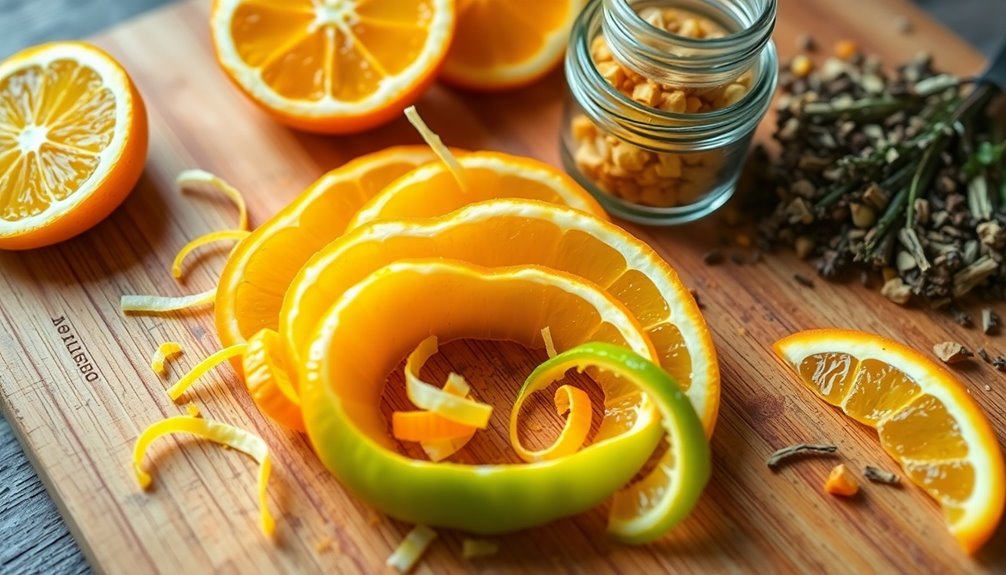
Citrus peel essence is a vibrant and aromatic way to enhance your culinary creations while reducing waste. When you essence citrus fruits like lemons, limes, or oranges, you're revealing a burst of essential oils that can elevate your dishes. It's not just about saving scraps; it's a chance to add brightness and depth to your meals.
Think about creative garnish ideas that can transform a simple dish into something extraordinary. A sprinkle of lemon essence on pasta or orange essence atop a chocolate dessert can create a delightful contrast that tantalizes the taste buds. Your guests will appreciate those little touches, making them feel special and welcomed.
You can also explore flavorful marinade options using citrus peel essence. Combine it with olive oil, garlic, and herbs for a zesty marinade that infuses your proteins or veggies with vibrant flavor. Imagine marinating chicken with lemon essence and thyme for a invigorating summer dish. The essence not only contributes taste but also adds a delightful aroma that fills your kitchen.
Next time you peel an orange or lemon, don't toss those peels away. Instead, reach for your microplane or zester and make the most of every bit. By incorporating citrus peel essence, you'll not only reduce waste but also create dishes that bring warmth and joy to your table, making everyone feel right at home. Additionally, utilizing custom keto diet plans can help you discover how to incorporate these flavorful elements into your meals while adhering to your dietary goals. So go ahead—get essencing!
Overripe Fruit Smoothies
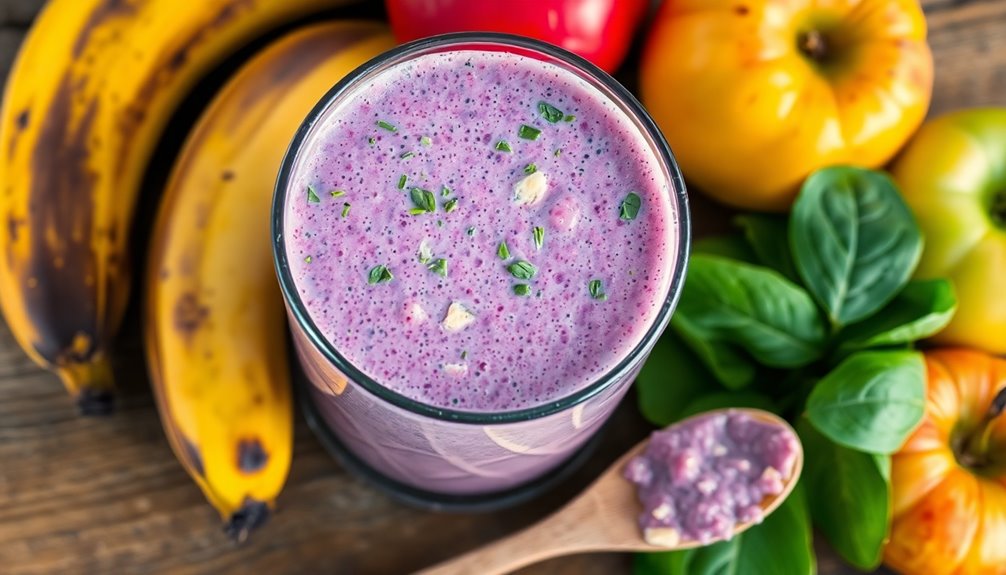
Transforming overripe fruit into smoothies is a delightful way to minimize food waste while enjoying a nutritious treat. When you spot those bananas turning brown or berries that are just a tad too soft, don't toss them! Instead, whip up a smoothie that not only tastes great but also helps you stay eco-friendly. You'll feel good knowing you're making the most of your groceries.
Start by gathering your overripe fruits. Bananas, peaches, and even apples work wonderfully. Toss them into your blender with a splash of yogurt or a scoop of your favorite nut butter for added creaminess.
For a revitalizing twist, consider adding spinach or kale; you won't even taste it! You can also throw in some ice cubes or frozen fruits to give your smoothie that perfect chill.
These vibrant blends make for healthy snacks that can energize your day or serve as a satisfying breakfast. Additionally, using overripe fruits in your smoothies can help you achieve weight loss results while keeping your meals delicious and nutritious.
Plus, if you want to get a little fancy, you can transform your smoothies into creative desserts by pouring them into bowls, topping them with granola, nuts, or seeds, and enjoying a beautiful, Instagram-worthy treat.
Herb-Infused Oils
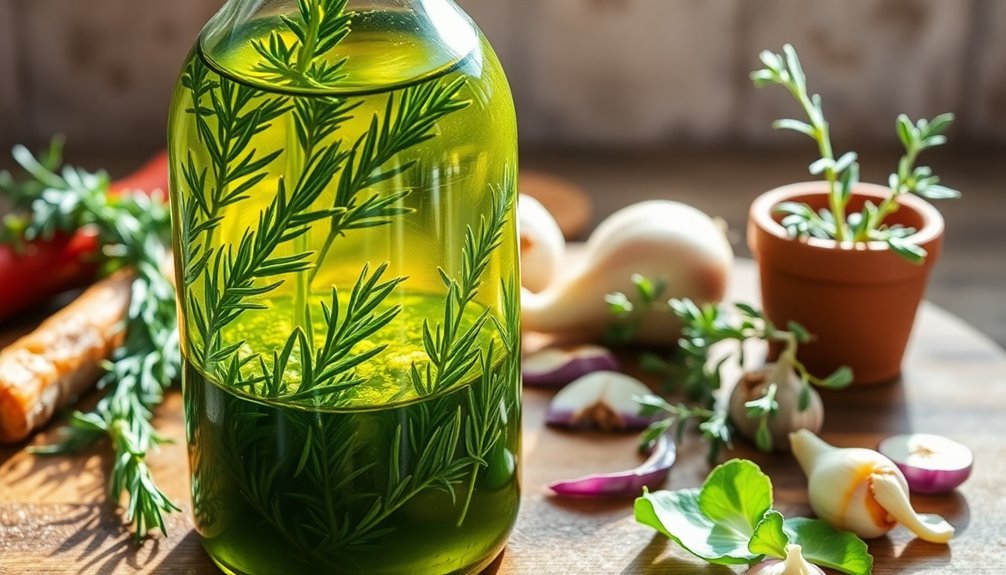
Elevate your culinary creations with herb-infused oils, a simple yet flavorful way to utilize leftover herbs from your kitchen. Whether you have a handful of basil, rosemary, or parsley, transforming these fragrant remnants into vibrant oils is both easy and rewarding. Infusing flavors into your oils not only extends the life of your herbs but also adds a personal touch to your dishes.
To create your own herb-infused oil, start by gently heating a neutral oil, like olive or grapeseed, in a saucepan. Add your chopped herbs, allowing them to soak in the warmth for about 20 minutes. This gentle heat helps release the essential oils, resulting in a beautiful infusion.
Afterward, strain the mixture through a fine mesh sieve or cheesecloth, and store your infused oil in a clean bottle.
The culinary uses for your herb-infused oils are endless. Drizzle them over roasted vegetables, use them as a dipping oil for crusty bread, or incorporate them into salad dressings for an extra layer of flavor. You can also experiment with different herb combinations to create unique blends that match your personal taste.
Sharing your herb-infused creations with friends or family can foster a sense of belonging, as you exchange cooking tips and inspire each other in the kitchen. So, next time you find yourself with leftover herbs, remember: you're not just minimizing waste; you're crafting a delicious addition to your culinary repertoire. Enjoy the journey of flavor!
Potato Peel Chips
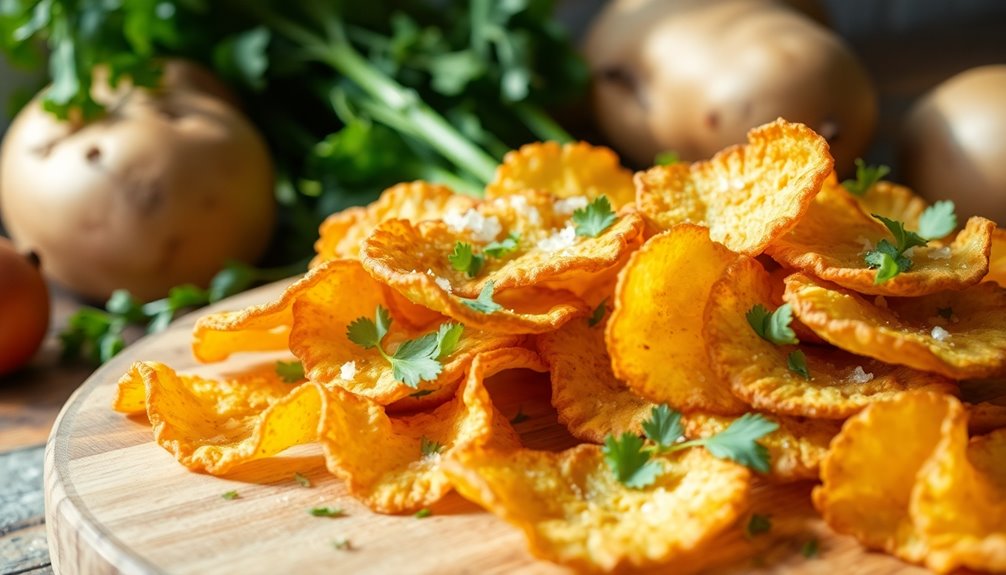
Instead of tossing out those potato peels after your next cooking session, consider turning them into a crunchy and delicious snack. Potato peel chips aren't only a fantastic way to reduce food waste, but they also provide a flavorful, guilt-free munching experience that everyone will love. You'll be amazed at how easy it's to transform those scraps into something special.
To make potato peel crisps, simply wash the peels thoroughly, removing any dirt or imperfections. Toss them in a bowl with a drizzle of olive oil, a sprinkle of salt, and your favorite seasonings—think garlic powder or paprika for a kick! Spread them out on a baking sheet and bake at a high temperature until they're golden and crispy. You'll find yourself snacking on these tasty treats in no time. Incorporating these snacks into your diet can help decrease sugar cravings, making your overall eating experience more enjoyable.
If you're feeling adventurous, why not take it a step further? Create potato skin nachos! Layer your crispy peels on a baking dish, sprinkle them with cheese, jalapeños, and any toppings you fancy. Pop them back in the oven until the cheese melts, and you've got a crowd-pleasing appetizer that's bound to impress.
Coffee Ground Exfoliant
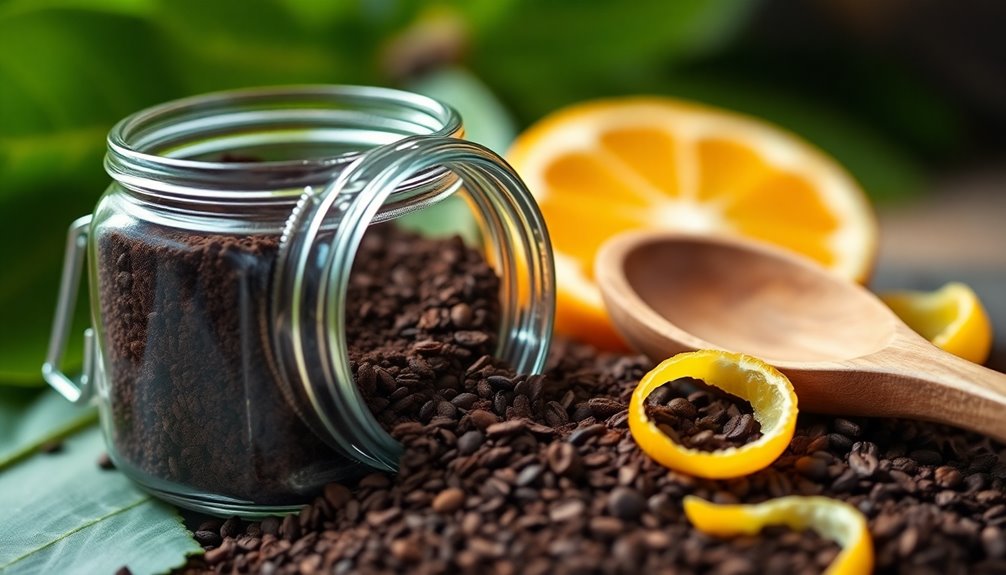
After enjoying those crispy potato peel chips, you might find yourself wondering how to make the most of your kitchen scraps in other ways. One fantastic option is transforming your used coffee grounds into a rejuvenating coffee ground exfoliant. Not only does this DIY beauty treatment elevate your skin care routine, but it also embodies sustainability by repurposing what would otherwise be waste.
To create your coffee ground exfoliant, simply combine a half cup of used coffee grounds with a few tablespoons of coconut oil and a teaspoon of sugar. Mix it all together until you achieve a paste-like consistency.
The coffee grounds serve as a natural exfoliator, gently buffing away dead skin cells, while the coconut oil hydrates and nourishes your skin. This powerful duo not only leaves your skin feeling refreshed and radiant but also exudes a rich, invigorating coffee aroma that can uplift your mood. Additionally, using plant-based ingredients in your beauty routine can align with a commitment to veganism, promoting a more sustainable lifestyle overall.
Using this exfoliant once or twice a week can improve your skin's texture, making it a delightful addition to your self-care routine. Plus, by opting for this homemade scrub, you're actively reducing your environmental impact and promoting a zero-waste lifestyle.
Pickled Vegetable Scraps
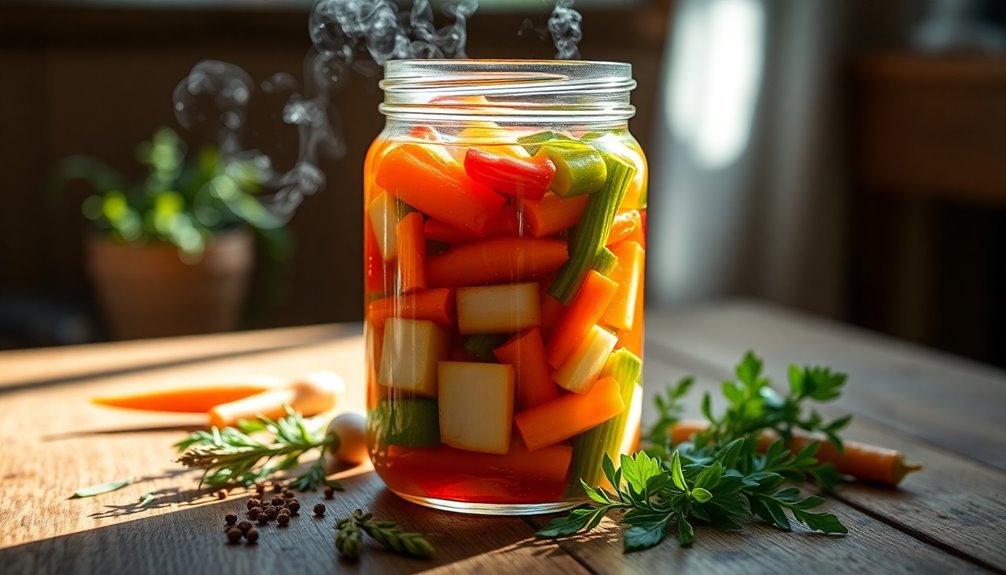
Have you ever considered how deliciously versatile your vegetable scraps can be? Instead of tossing those peels, stems, and ends, why not turn them into vibrant pickled veggie scraps? It's an easy way to reduce waste while adding a burst of flavor to your meals.
The beauty of pickling is in the flavor variations you can create, allowing you to customize your recipes according to your taste buds.
To get started, gather your scraps—think carrot tops, radish greens, or onion skins. You can mix and match your leftover veggies, creating a colorful medley that will brighten up any dish.
For a simple brine, combine equal parts vinegar and water, add a pinch of salt, and toss in some sugar for sweetness. Feel free to experiment by adding spices like dill, mustard seeds, or garlic for that extra kick.
Once your brine is ready, pour it over your creative pickled recipes in a jar filled with your chosen scraps. Seal it up and let it sit in the fridge for a couple of days.
The result? A tangy, crunchy delight that can be used on sandwiches, salads, or as a snack on their own! Additionally, embracing these creative uses for scraps can help you unlock health secrets that contribute to better well-being.
Frequently Asked Questions
How Can I Safely Store Food Scraps Before Using Them?
To safely store food scraps, you should prioritize proper storage methods.
For fresh scraps, like vegetable peels, keep them in an airtight container in the fridge for maximum freshness.
For cooked scraps, let them cool before sealing them in a container.
Label everything with dates to avoid confusion.
Can I Use Scraps From Cooked Vegetables?
Did you know that about 30-40% of the food supply in the U.S. is wasted?
You can definitely use scraps from cooked vegetables! Fresh produce peels or leftover roasted vegetables can add flavor to stocks or soups. Instead of tossing them, think of ways to incorporate those scraps into your meals. Not only do you reduce waste, but you also create delicious dishes that your friends and family will love.
Are There Any Scraps That Shouldn't Be Repurposed?
When considering scraps to repurpose, be cautious of toxic scraps. Certain vegetable peels, like those from potatoes if they appear green or sprouted, can be harmful.
Always prioritize safety precautions—refrain from using scraps from spoiled or moldy produce.
It's crucial to trust your instincts; if something seems off, don't use it.
What Is the Best Way to Clean Food Scraps?
When cleaning food scraps, you'll find natural cleaning solutions are both effective and eco-friendly. Start by mixing equal parts of vinegar and water for a simple DIY solution that cuts through grease and odors.
For tougher stains, sprinkle baking soda, let it sit, and scrub gently. This approach not only keeps your kitchen clean but also promotes sustainability.
You'll feel good knowing you're doing your part for the planet while maintaining a tidy space!
How Long Can I Keep Repurposed Food Scraps in the Fridge?
You can typically keep repurposed scraps in the fridge for about three to seven days, depending on the type of food. Always check for any signs of spoilage before using them. Remember, the shelf life varies, so sticking to expiration dates is essential. Storing them in airtight containers can help extend freshness. By being mindful of your fridge storage, you'll not only reduce waste but also make the most of every bite!
Conclusion
By embracing these easy recipes, you're not just reducing waste; you're transforming your kitchen into a treasure trove of flavors. Just like the pioneers who made the most of every resource, you can creatively repurpose food scraps into delightful dishes and handy products. Whether it's brewing a savory stock or whipping up crispy chips, every scrap has potential waiting to be discovered. So roll up your sleeves and start cooking—your meals and the planet will thank you!

